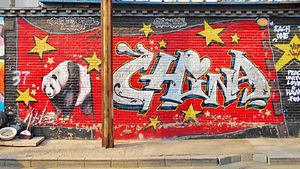This is part one of a two-part series on graffiti in China.
After Ed Seymour invented spray paint in 1949 and Sidney Rosenthal invented the Magic Marker in 1953, modern graffiti started appearing in Philadelphia and New York in the 1960s. In 1971 The New York Times ran a story about graffiti writer TAKI 183, Jean-Michel Basquiat started tagging “SAMO” in 1976, and three years later Fred Brathwaite (Fab 5 Freddy) told Village Voice, “graffiti is the purest form of New York art.” That year, he and Lee Quiñones had a show at Galleria La Medusa in Rome.
Modern graffiti has gone global since then, and one of its most exciting venues today is China. In 1989, a Beijing art student named Zhang Dali moved to Italy in the wake of the failed democracy protests of 1989. There, he encountered graffiti. Upon returning home in 1995 he began tagging “AK-47” and “18K” in reference to the violence and materialism of modern China. Dali became the nation’s first, and most famous, graffiti writer and in 2010 his work was exhibited, along with Ai Weiwei’s, in New York’s Museum of Modern Art (MoMA).
To call Dali the nation’s first graffiti writer warrants explanation, since graffiti is an ancient form of expression and history is littered with other examples of Chinese graffiti. In Journey to the West, even the money king does graffiti. There’s also the poet Huang Xiang, who traveled to Beijing in 1978 with a bucket of flour paste and plastered sheets of his poem, “The Fire God Symphony,” near Wangfujing Avenue. Huang then took a brush to Tiananmen Square and wrote, “Mao Zedong was thirty percent right and seventy percent wrong!” That area, later known as Democracy Wall, was also where Wei Jingsheng posted his famous essay, “The Fifth Modernization,” before the Wall was shut down in 1979 and Wei was imprisoned for 15 years.
Yet these are not what we would call “modern graffiti” writers, artists affiliated with the graffiti movement that emerged from 1970s New York hip hop culture, as exemplified by Banksy, Shepard Fairey, Keith Haring, Malina Suliman, Zhang Dali and Tsang Tsou Choi, who for years bombed Hong Kong with the chucklesome tag “King of Kowloon,” then pulled in a sober sum of $7,000 at a Sotheby’s auction in 2004, his first major commercial success.
Even in this modern sense, though, graffiti is difficult to define. It has no unifying ideology or medium (aerosol paint, Magic Marker, stencil, and yarn are all common). Some consider it “street art,” but increasingly it fills galleries. Others call it “illicit art,” except it isn’t always illegal. China worries this boundary most of all — here, graffiti is often state-sponsored and writers “rarely face punishment.”
This is what makes China one of graffiti’s more outré scenes. Speaking to Public Radio International, Lance Crayon, creator of the film Spray Paint Beijing, said, “as long as you stay away from anything political […] you’re not going to have a problem.” In his film, a police officer encourages a writer to keep going. Even more impressive, the city of Chongqing is home to an area of 50,000 square meters where students can unload their cannons against walls without any fear of being fined. Also, leading up to the 2008 Olympics the government sanctioned a 730-meter-long graffiti display called the “Wall of Beijing,” and in March 2014 The Guardian reported that a section of the Great Wall itself would be open to graffiti. This kind of freedom is rare for writers, but it isn’t without limits.
For one, spray cans are prohibitively costly in China. Most writers are therefore wealthy art students, snagging deals with brands like “Red Bull, Adidas and Louis Vuitton.” As one reporter quipped, “in America graffiti is a sign of a decaying neighborhood. In China it’s a yuppie hobby.” However, such criticism conveniently overlooks the massive commercial successes of Banksy, Fairey and others.
Second, this freedom causes many to self-censor for fear of losing the privilege. As Zhang Dali notes, “graffiti is the fashion in China these days and has lost its meaning as protest.” Even gentler voices are silenced. In January Julien Malland and Shi Zheng wrote over two Shanghai demolition sites, tenderly depicting children clinging to miniature homes. Images of their work went viral. Some came “wanting to use the painting as backdrops for their wedding photos.” The city destroyed the works, citing safety concerns.
This concrete inflexibility toward dissent is, predictably, beginning to stir dissent. Lack of freedom and inequality have created the kind of tension that inspires graffiti writers, and despite its American roots, this tension might just be the “crack in the concrete” from which this flowering art form fully blossoms.
Coming soon: a look at how China muffles dissent while encouraging graffiti that meshes with the Party line.
































